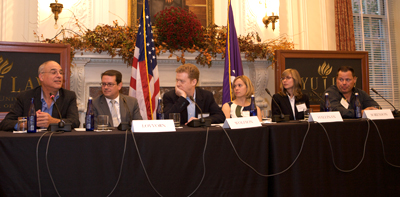The following account was written by Elizabeth Hallinan ’13, who was one of the organizers of the program, and then moderated the discussion.
On Tuesday, October 25th, NYU Law’s Student Animal Legal Defense Fund and the Environmental Law Society hosted a panel to discuss another crisis in the American food culture – the prevalence of Concentrated Animal Feeding Operations (CAFOs), colloquially known as factory farms.
As explained by Nebraska farmer Kevin Fulton of the sustainable Fulton Farms, CAFOs are not the mom-n-pop family farm pictured on your milk carton. CAFOs, as explained by the EPA, are “agricultural operations where animals are kept and raised in confined situations…which congregate animals, feed, manure and urine, dead animals, and production operations on a small land area.”
 Panelist Mark Bittman, a columnist and long-time food writer for the New York Times, is worried about the environmental damage these operations can do. CAFOs are major polluters of both local toxins (for example when manure lagoons overflow into local waterways) as well as greenhouse gases from both the facilities and the animals themselves. Bittman has written extensively about the problems stemming from the over-consumption of meat in the U.S. On the panel, he claimed that meat is not as cheap as it seems to be. He pointed out that if we included the extensive environmental and health costs to society - what economists call “externalities” of the system - the price of a steak dinner is actually very expensive. According to Fulton, Americans used to spend far more money on food than on health insurance. Now that ratio is reversed.
Panelist Mark Bittman, a columnist and long-time food writer for the New York Times, is worried about the environmental damage these operations can do. CAFOs are major polluters of both local toxins (for example when manure lagoons overflow into local waterways) as well as greenhouse gases from both the facilities and the animals themselves. Bittman has written extensively about the problems stemming from the over-consumption of meat in the U.S. On the panel, he claimed that meat is not as cheap as it seems to be. He pointed out that if we included the extensive environmental and health costs to society - what economists call “externalities” of the system - the price of a steak dinner is actually very expensive. According to Fulton, Americans used to spend far more money on food than on health insurance. Now that ratio is reversed.
As we have moved from family farms to factory farms, other unintended consequences have arisen. Jen Sorenson, a litigator with the Natural Resources Defense Council explained that 80% of all antibiotics in the US are fed to CAFO animals. These antibiotics are given subtherapeutically, meaning they are used not to improve animal health, but to enhance growth rate and improve feed efficiency. Unfortunately, as Bittman pointed out, this extraordinary overuse of antibiotics contributes to the growing prevalence of “superbugs” that are resistant to therapeutic use of these antibiotics when animals, and humans, need treatment.
As one audience member commented after the panel, the problem with discussing factory farming is that you pull the thread of one problem, and the entire system starts to unravel. Animal welfare, worker safety, labor rights, and many other issues are implicated in the mess of the CAFO system.
So what can we do? Bittman wishes we would cook more at home and rely less on the food industry to tell us what we should eat. Sorenson suggested that focusing on the human health concerns is the best tactic in litigation aimed at curbing CAFOs. Jon Lovvorn, an attorney at the Humane Society of the United States, has found nuisance law to be a fruitful litigation approach. And Fulton invited the entire audience to see a sustainable farm at work in Nebraska. Judging by the warm reception given to him, and all our speakers, by the audience that night, I might not be the only one to take him up on his offer.
Posted on November 4, 2011